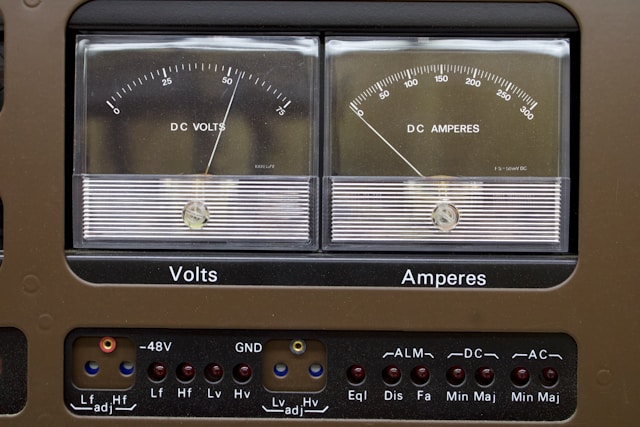
Electricity stands as a critical integral in our daily life, from household equipment to bigger machines at the industrial level. In order for one to relate to how electricity works, they need to have a proper understanding of the basic units of measure used in electrical engineering: volts, amps, and kilovolts. This paper will explain in detail these units, their conversion, and also provide some real-life application examples, so that everyone can understand the important basics of the named concepts.
What is Voltage?
Volts (V) are the standard unit of measurement for electric potential or electromotive force. In easier terms, a volt is used to measure the size of the electric potential difference between two points in an electric circuit. Analogously, voltage can be considered as the pressure propelling electricity charges along the conductor. The larger the voltage, the more force there is to drive the electric current.
Real-Life Example:
Let’s say you have a common household battery, like an AA. Normally they will give you around 1.5 volts. That is enough for things like remote controls or flashlights. In comparison, the normal voltage for most household power outlets anywhere in the world is 120 volts or 240 volts—that’s powerful enough to run refrigerators and washing machines.
What is an Amp?
Amps (A) are the abbreviation for amperes, referring to the amount of electric current that flows through a conductor. An electric current is the flow of electric charge, and the ampere quantifies the rate at which this charge moves. One ampere is equal to one coulomb of charge passing through a point in a circuit per second.
Real-Life Example:
The way I visualize it is like water flowing through a pipe. Voltage is the pressure pushing the water, but current is the quantity of water that is moving through the pipe, measured in amps. With high voltage and a small pipe (high resistance), only a little water (current) will flow, but with a wide pipe, more water will flow.
Understanding Kilovolts
Kilovolts (kV) refers to a larger magnitude of the unit for measuring voltage. This usually replaces volts in power transmission lines and large industrial equipment by values taken as 1 kV equivalent to 1,000 volts. High values of voltages are necessary if very efficient transmission of power over very long distances is to take place and minimize the amounts of energy lost during transmission.
Real-Life Example:
The power generated by the power plant is at very high voltages, usually in the hundreds of kilovolts. This high voltage is then transmitted to houses over long distances through power lines, being further brought down to 120 volts or 240 volts with transformers.
Converting Volts to Kilovolts
To convert volts into kilovolts: divide the value of volts by 1,000. To convert kilovolts to volts: multiply the value of the kilovolt by 1,000.
Conversion Example:
Suppose you have 5,000 V and convert that into kilovolts: 5000 volts÷1000=5 kilovolts5000 \text{ volts} \div 1000 = 5 \text{ kilovolts}5000 volts÷1000=5 kilovolts
If you have 2 kilovolts and wish to make the conversion to volts: 2 kilovolts×1000=20002 \text{ kilovolts} \times 1000 = 20002 kilovolts×1000=2000
Real World Applications
Knowledge about volts, amps, and kilovolts is very essential in a number of practical life applications:
- Household Electronics: It helps to know the voltage needs of different household electronics for the safe and efficient use of them.
- Electric Vehicles: Electric vehicles critically depend on the understanding of battery voltage and current to function.
- Power Transmission: The kilovolts enable engineers to create and service power grid systems that efficiently transmit electricity over very long distances.
- Industrial Machinery: Several industrial machines are run at high voltages and currents, whose control may be a matter of safety and efficiency.
Frequently Asked Questions (FAQs)
Q1: What is the difference between volts and amps?
*** Volts refer to the difference in electric potential; amps define the rate of flow of electric current. Think of volts in terms of the force pushing the current through a conductor and think of the flowing current’s amount as amps.
Q2: How do I convert volts to kilovolts?
A2. Dividing by 1,000 converts the unit of measurement in volts to kilovolts. Illustration: 3,000 V = 3 kV (3,000 ÷ 1,000).
Q3: Why does power transmission require kilovoltage?
A3. Kilovolts are used for power transmission so that electricity can be transported economically over long distances with little energy lost. A very high voltage means a very low quantity of lost energy, which further implies that delivering electricity from power stations to homes and businesses is quite cost-effective.
Q4: What is the voltage rating of typical household electrical outlets in most households?
A4: Various countries will have different typical voltages at which domestic electrical outlets run. For example, in the USA, it would be 120 volts; on the other hand, for most European countries, it would be in the range of 240 volts.
Q5: Can I measure the voltage and current myself?
A5: Absolutely, with the proper tool, a multimeter, one can measure both voltage and current in an electrical circuit. But, one must handle electricity carefully; if uncertain, practice safety or check with someone who may know.
Conclusion
These are the most basic units of electricity, and understanding them could present the core to any electronics or electrical engineering concepts. These units are used to describe how the systems interact and operate electrically from the simplest home appliance to a sophisticated power grid. This understanding of the very basic units of their life application should enable students and members of the general public to appreciate the important roles that electricity plays in modern society.



